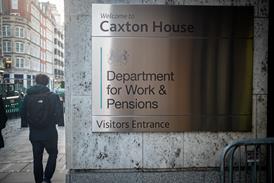A High Court judge has ruled that a key feature of the Pension Protection Fund’s benefit structure is illegal on age discrimination grounds, leaving the defined benefit lifeboat liable for back payments to wealthier pension members.
In a judgment handed down on Monday, Mr Justice Lewis held that the PPF’s cap on deferred members’ benefits, currently set at £41,461 at age 65, was unlawful, enabling capped members to claw back up to six years of underpayments.
The cap has already been implicated in another landmark legal challenge, known as the Hampshire case, in which the Court of Justice of the European Union determined that PPF members should not receive less than 50 per cent of their entitled benefits, in the event of the insolvency of their employer.
However, Justice Lewis went further in his judgment, arguing that the cap itself – which is applied to members who have not yet reached normal retirement age – is discriminatory on the grounds of age.
The PPF operates a split benefit system, whereby members who are past normal retirement age when their scheme sponsor becomes insolvent are paid their full benefits, albeit sometimes with lower annual increases. Deferred members, however, see their benefits cut to 90 per cent of their original entitlement, and capped.
This ruling is great news for thousands of workers whose pensions were capped simply because their company went bust before they reached pension age
Steve Webb, LCP
Member cuts too drastic
Twenty-five claimants challenged the PPF’s Hampshire solution, which saw a calculation run of the total value of both the original benefit and PPF compensation, followed by a one-off top-up. The case relied on the example of Mr Hughes, who took early retirement and a pension of £66,245 in 2003, only to see his benefit cut to £17,481 when his scheme entered the PPF assessment period before he reached normal retirement age.
As well as considering the issue of discrimination, the judge was asked to confirm the method used by the PPF to top up benefits, the limitation period for arrears payments, what interest rate should apply in these cases, and whether trustees are bound to pay PPF-level benefits during the assessment period.
The court concluded that parliament had a legitimate aim in limiting the PPF’s payouts to members below NRA for reasons including moral hazard, and Justice Lewis even wrote that it “is open to parliament to decide that an appropriate and necessary means of achieving those aims is to pay 90 per cent of pension benefits”.
“Ultimately, however, I am driven to the conclusion that the compensation cap, as originally enacted and as modified in 2017 was not, in the circumstances of this case, an appropriate means of achieving the aims,” he wrote.
As a statutory benefit, the court decided that a limitation of six years could be applied to claims for repayment, but declined to give an opinion on an appropriate interest rate.
The British Airline Pilots’ Association, one of the claimants, welcomed the decision. General secretary Brian Strutton said: “Many of our members who used to fly for Monarch and BMI have suffered a huge detriment because of the unlawful PPF compensation cap, which resulted in many of them getting much less than their contracted pension scheme benefits, sometimes less than half of the pension they were expecting.
“Today’s judgment ends that practice and means that professional people who have worked hard for many years and whose pensions – through absolutely no fault of their own – have ended up in the PPF, will in future receive PPF compensation equivalent to the vast bulk of the pension they were expecting and are now well placed to claim arrears for underpayments made since 2012.”
PPF to consider impact
The impact of the ruling on the PPF, and the solvent schemes whose levies will have to rise if its funding is damaged, is unclear. The lifeboat paid out an average of just £3,846.67 to its 201,473 pensioner members in 2018-19 – well below the cap – and has previously said that the Hampshire case affected less than 1 per cent of members, although the number impacted by the High Court judgment will necessarily be larger.
A PPF spokesperson said: “We’re studying the detail of the judgment carefully to decide our next steps, and we will work closely with the Department for Work and Pensions to understand how the UK government will respond. While we do so, we’ll continue to pay our members their current level of benefits.”
Steve Webb, former pensions minister and partner at consultancy LCP, said: “This ruling is great news for thousands of workers whose pensions were capped simply because their company went bust before they reached pension age. But it could have a much wider knock-on effect.”
He said that although Justice Lewis had backed the application of the 90 per cent cut, this was not a question asked by the claim, and could be interpreted differently by another judge.
PPF: DWP is ‘key’ for Bauer solution
The Pension Protection Fund hopes to use Department for Work and Pensions data to help it implement tricky increases required by the landmark Bauer judgment, according to Sara Protheroe, chief customer officer at the PPF.
“If it is discrimination to cap compensation on larger pensions only for those under pension age, there could be further legal challenges to the whole principle of only paying 90 per cent compensation across the board for those under pension age. This could have much more far-reaching implications for the overall size of the PPF levy and for the levy payable by individual schemes and employers,” Sir Steve said.
Angela Sharma, senior professional support lawyer at Taylor Wessing, said that the case had revolved around whether the PPF's benefit structure was compliant with the aims of the relevant provisions of the Insolvency Directive and the application of the 50 per cent principle established by Hampshire.
She explained that the drastic impact of the cap on some members could be seen to undermine the core principle of protecting benefits, but that the 10 per cent cut (without the cap) could more easily be shown to be consistently above what the directive would expect.*
"What you've got is this cap, which completely flies in the face of that, to enough of an extent for it to matter," she said.
Ms Sharma said that if the cost of removing the cap is low enough, the PPF may instead decide to spend its time figuring out the implications of another EU judgment, known as the Bauer case.
In this case, it was established that a member’s total income should never fall below the Eurostat poverty threshold as a consequence of PPF cuts, despite the lifeboat not having access to all the relevant information to assess this.
“How on earth do you go about assessing that, because that’s essentially looking at somebody’s income as a whole,” she said.
*This article has been updated to correct an inaccuracy in the reporting of the PPF's benefit cut for deferred members






















